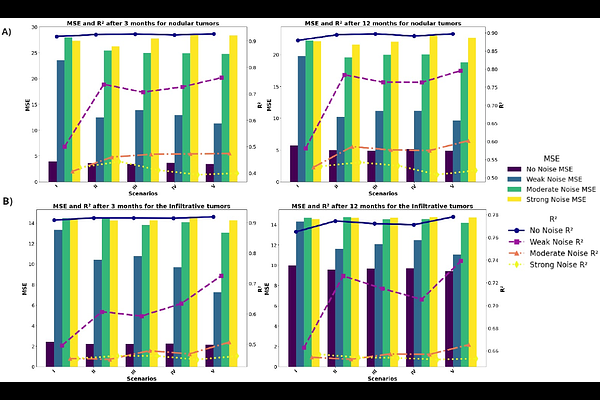The Role of Biopsy Position and Tumor-Associated Macrophages for Predictions on Recurrence of Malignant Gliomas: An In Silico Study

The Role of Biopsy Position and Tumor-Associated Macrophages for Predictions on Recurrence of Malignant Gliomas: An In Silico Study
Shojaee, P.; Weinholtz, E.; Schadt, N. S.; Feuerhake, F.; Hatzikirou, H.
AbstractPredicting the biological behavior and time to recurrence (TTR) of high-grade diffuse gliomas (HGG) after the maximum safe neurosurgical resection and combined radiation and chemotherapy plays a pivotal role in planning the clinical follow-up, the choice of potentially necessary second-line treatment, and the quality of life of patients faced with the diagnosis of a malignant brain tumor. The current standard-of-care (SoC) for HGG includes follow-up neuroradiological imaging to detect recurrence as early as possible and several clinical, neuropathological, and radiological prognostic factors with limited accuracy toward predicting TTR. Herein, using an in-silico analysis, we aim to improve predictive power towards TTR considering the role of (i) prognostically relevant information available by diagnostics used in current SoC, (ii) advanced image-based information that is currently not part of the standard diagnostic workup, such as interface of tumor and normal tissue (edge) features and quantitative data specific for the position of biopsies within the tumor, and (iii) information on tumor-associated macrophages. In particular, we introduce a state-of-the-art spatio-temporal model of tumor-immune interactions, emphasizing the interplay between macrophages and glioma cells. This model serves as a synthetic reality for assessing the predictive value of various features. We generate a cohort of virtual patients based on our mathematical model. Each patient\'s dataset includes simulated T1 and FLAIR MRI volumes, and simulated results on macrophage density and proliferative activity either in a specified part of the tumor, namely tumor core or edge (\"localized\"), or unspecified (\"non-localized\"). We impose different levels of noise to enhance the realism of our synthetic data. Our findings reveal that macrophage density at the tumor edge contributes to a high predictive value of feature importance for the selected regression model. Moreover, there is a lower MSE and higher $R^2$ for the \"localized\" biopsy in prediction accuracy toward recurrence post-resection compared with \"non-localized\" specimens. In conclusion, the results show us that localized biopsies can bring more information about the tumor behavior, especially at the interface of tumor and normal tissue (Edge).